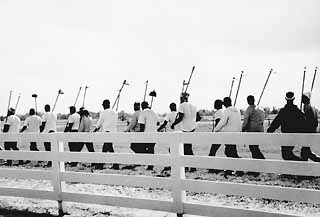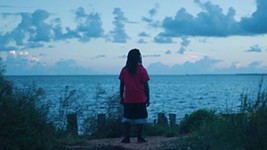Life and Nothing But
By Anne S. Lewis, Fri., Nov. 6, 1998

Liz Garbus, co-directorwith Jonathan Stack of The Farm, says their film is not a "prison" documentary, but rather a story tied to its unique setting, Angola, the former slave plantation now a maximum-security Louisiana "lifer" penitentiary -- the largest in the country -- which houses 5,000 mostly black inmates. The Farm is not, however, about the violent seventh circle of hell that we've heard Angola to be. The pertinent statistic for this film is that 85% of those who enter Angola will never leave. It's the prospect of spending one's life behind bars that hovers over every scene in this incredibly visual film and which infuses every shot and dialogue with a second layer of meaning. The Farm, which took top honors at Sundance last year, will be screened at the Alamo Drafthouse on Wednesday, Nov. 11, with Stack in attendance.
The film is a moody, evenhanded think piece, rich with telling visual detail, that follows six inmates at different stages of their life sentences, each of whom seems to honestly believe he stands a good chance of making it out of Angola. And though we may be initially buoyed by their optimism, spiritual transformations, and how long ago their crimes were committed, as the film progresses we come to see what pathetically slim reeds these hopes are staked on. Paradoxically, it seems that hope is the only way to pass the time in this kind of institution. Warden Burl Cain, an often sympathetic narrative voice, offers another use for it: "If we keep the despair down and the hope up, they won't try to escape." Wearing them out in the fields every day -- for 4¢ an hour -- at the self-sustaining farm also helps.
In the end, The Farm prods us, at every juncture of these inmates' lives, to consider what exactly we seek to accomplish when we incarcerate criminals for years and years. Ultimately, The Farm is about whether, in our system of justice, there is ever the possibility of forgiveness for those, seemingly rehabilitated, who nevertheless have done terrible deeds.
John Brown, 35 -- incarcerated since he was 12, on death row at Angola for 12 years, which means lockdown 23 hours a day -- has faith up to the last that the clemency board will spare him. Newly installed in his Camp F death house cell, 16 hours before his scheduled execution, Brown cheerfully comments on the nice view. "Like the sun," he says, nodding up at the barred window across from his cell. Even what's left on the table after his last meal with his family -- the paper plate of crawfish shells, the left-for-later, half-empty Styrofoam cup of coffee -- seems hopeful. Or maybe it's the fact that he was able to eat at all.
Twenty-two-year-old convicted murderer George Crawford, whom we meet while being bused into his new "home" at the start of his life sentence, has "hope" that he'll get the funds necessary to appeal his conviction, the assumption being that money will be the ticket to his freedom. As he goes through the introductory "boot camp" orientation, inventorying and surrendering his worldly possessions, the camera lingers on a pair of street-smart black patent-leather loafers that couldn't be more perfectly emblematic of his former existence -- "Guess I won't be needing these," he mumbles as he gets fitted for a pair of prison work boots. Clearly, Crawford does not realize that Angola is "forever," that it's unlikely he'll ever wear those shiny loafers again. Not yet institutionalized, repentant, or even chastened, he seems almost mystified as to why his mother breaks down weeping during her first visit with him in the prison rec room. The narrator points out that the average prisoner receives no visitors after three years.
Vincent Simmons, at 45, and 20 years into a 100-year sentence for two rapes, has spent much of his confinement in the law library seeking a forum that will be receptive to the stack of newly discovered, exculpatory evidence he's put together. This includes a statement by one of the victims that she couldn't possibly identify the perpetrator because all black men looked alike to her and a photo of the lineup where he's the only one in handcuffs. Simmons' big day finally arrives: the hearing before a three-man parole board. While few will be surprised by the results of this minutes-long hearing that Simmons has spent 20 years preparing for, the fact that the filmmakers were allowed to film the actual proceedings, which included an appearance by one of the victims -- whose pain and agitation has remained undiminished over the years -- is truly amazing. Though even that is not as amazing as the fact that The Farm has been roundly praised by both Louisiana prison officials -- who want to use it for guard training programs -- and the governor's office. "Now that really surprised us; I won't even try to explain it," says Garbus. "I suppose that everyone takes what they want into a film."
Then there's 65-year-old Eugene "Bishop" Tannehill, whom we watch leading inmates in prayer for repentance and redemption. Thirty-eight years into his life sentence, Tannehill says he feels like he's been "raised" in Angola; he was even ordained as a minister while doing time. But he sees freedom just around the corner -- he's been recommended for a pardon. That recommendation, however, has been sitting on the governor's desk for quite some time and the governor has yet to sign a pardon during his term of office. Logan "Bones" Theriot, 26 years into his life sentence for murdering his wife (when she refused to stop hurting the child she'd had with his best friend while he was in the military) will die before Christmas of lung cancer, at 61. "Angola is not as terrible a place as one might think," he says, waxing philosophical from his hospital bed, the product of complete institutionalization, "you can still have a life inside -- you can learn a trade." Theriot will shock his fellow inmates and family by choosing to be buried in the prison cemetery where, he says, his friends are. Lastly, there's Ashanti Witherspoon, 25 years into his 75-year armed robbery sentence, the model of rehabilitation, who's risen to the rarefied ranks of Class A trustee and who even enjoys the privilege of leaving the prison to travel around the state conducting programs for at-risk youth. Ashanti seems the perfect parole candidate -- he seems like an Angola staffer -- but he can't even get a parole hearing. Perhaps because he's made himself so indispensable to his captors.
Garbus became interested in Angola after reading a book about life sentences by Wilbert Rideau, an Angola inmate and one of the film's co-directors. Rideau, now 56 and serving life without parole for a 1962 murder (his death sentence was commuted in 1972) is the editor of the award-winning prison newspaper, The Angolite. Rideau, who in a Life magazine profile six years ago was called "the most rehabilitated prisoner in America," worked closely with the filmmakers on two Angola films, guiding them through the prison maze and its cast of characters.
|
|
Austin Chronicle: What is it about Angola that has attracted and held Jonathan Stack's and your interest through two film projects, The Farm and Final Judgment: The Execution of Antonio James?
Liz Garbus: At Angola, you see all these lives that are basically forgotten, lives whose promise has been stripped away, people who have done something terribly horrible and inflicted total pain on other people. There's this ripple effect of tragedy and injustice, some of which these inmates have created and some that's been done to them. You won't find a more Kafkaesque place in terms of the magnitude of existential questions that Angola raises.
AC: How does Angola differ from other prisons?
LG: Angola is this poignant place because you've got the former slave plantation history in the context of a present-day 1,800 acre farm with a predominantly black inmate population and a 100% white administration. Also, the tenor of a prison where so many are serving life sentences -- no one is serving less than 15 years -- is different than at other prisons where many are serving shorter sentences. We wanted to make a film about what it means to live a life behind bars and to die in a world where there's no freedom -- and what it means to transgress. A lot of the Angola inmates were very reflective and philosophical about what it means to take a life, the crimes they had committed. When you're serving 20 or more years, this prison is your home. You have to figure out how to get along with people, how to create a meaningful life in this context. Quite a few turn to religion to deal with these questions.
AC: How were you able to get the access that you needed to make the film?
LG: Well, with a prison film, access is the overriding issue. When we made our first Angola film, there were lots of restrictions on where we could go. We'd be told we could only be in death row for three hours and then we'd find ourselves in the warden's office being fed cookies but not shooting. But at some point, I suppose it was because we'd been around so long, people finally came to trust us. The turning point seemed to be during the Christmas sequence when we wanted to go to Camp J, where the worst offenders are kept, to see how Christmas Eve is celebrated. We'd never been allowed there before but all of a sudden they said it was okay.
AC: That scene was really stark and powerful. [A trio of visiting Christian missionaries, one of whom is dressed as a clown (a clown!) walks down a row of solitary confinement cells, dispensing hollow tidbits of Christmas cheer to inmates who sit impassively on their beds staring into space, while the Angola radio station plays Christmas carols in the background. "Just checking to make sure your spirits are up," the missionaries say. "Remember what it's all about: the man upstairs."] So what was it like spending all this time shooting a film in a prison?
LG: We were there shooting the film for about a year but we'd shuttle back and forth between Angola and New York. Our longest shooting period was about two and a half weeks. For our own sanity we needed to come and go throughout the shoot. The place is totally isolated and the prison population is so intense -- everyone is in such pain and even with someone who's doing okay, you know there's a victim out there whose life he's affected and affected horribly. After a few days, being there begins to weigh on your soul and sanity and in order to bring some perspective and energy to the project we just needed to take a break.
AC: Did you have a mechanism for evaluating the bona fides or credibility of the inmates you follow in the film?
LG: Wilbert Rideau was our major guide; he told us what was real and what was bullshit. One thing you have to be aware of when you're shooting a film in a prison is that there are 5,000 men there, many of whom have no chances, and they see a camera and they think "there's a chance." You have to be very careful of cons. We had to listen and evaluate each's material very carefully.
AC: Which scenes in the film are you the most pleased with?
LG: Well, Vincent's parole board hearing has prompted a big response from audiences -- people are moved and enraged by it. They're surprised by it though we, having spent so much time there, were not at all surprised by it. But we're happy to have this scene which to us depicts race relations and justice in the Old South, and shows what happens to blacks without money.
The edited sequence that I love is what we call the "waiting montage," which we think captures the essence of what it's like to be in prison. On TV, prison is a lot of yelling and screaming. But really, prison, at least at Angola, is nothing. It's hours and hours of sitting around doing nothing or doing the same thing over and over and over again, until your life is over. Of course, you'd have to make a 200-hour film to make people feel as bored as you are in prison but I think this montage is effective at showing the tyranny and emptiness of time and the longness of one's sentence -- this being the overwhelming feeling in prison.
AC: Has anything happened as a result of making The Farm?
LG: Vincent Simmons now has legal counsel and that's meaningful. Ashanti, who is Mr. Rehabilitated in the film, now has hundreds and hundreds of pen-pals and marriage proposals and lots of the guys are getting letters. But, nobody's walked out of prison.
The Farm will be presented as part of the Texas Documentary Tour on Wednesday, November 11 at the Alamo Drafthouse, at 7 & 9:30pm; tickets for both shows go on sale at 6:30pm. Admission is $5 for the general public; $3.50 for Austin Film Society members and students. Co-director Jonathan Stack will introduce the film and conduct a Q&A session after each screening. The Texas Documentary Tour is a co-presentation of the Austin Film Society, the University of Texas RTF Dept., The Austin Chronicle, and SXSW.









